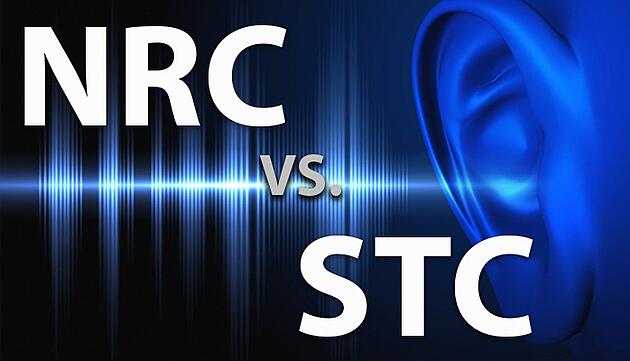The two terms Noise Reduction Coefficient (NRC) and Sound Transmission Class (STC) can be confusing, and both are important to know when choosing soundproofing materials for mechanical piping systems. While one measures the build-up of noise within a space, the other measures the sound transmission between spaces. This blog will cover the difference between the two ratings.

Noise Reduction Coefficient (NRC)
NRC is a standard rating for how well a material absorbs sound at normal speech frequencies. It is measured between zero and one. A NRC of zero indicates perfect reflection; a NRC of one indicates perfect absorption. If a product has a NRC rating from .75 - .82 the product will absorb 75% - 82% of the sound that it comes into contact with and will reflect 18% - 25% of the sound back into the space.
NRC doesn’t address a material’s barrier effect and doesn’t give information as to how absorptive a material is at low and high frequencies. NRC is only the average of the mid-frequency sound absorption coefficients (250, 500, 1,000 and 2,000 Hz) rounded to the nearest 5%.
It is also important to note that different materials with the same NRC may provide very contrasting results and frequencies may be absorbed differently.
Sound Transmission Class (STC)
STC is the most common rating used in North America for determining airborne sound transmission loss between 125 and 4,000 Hz. This range covers the majority of common noises we can hear. The higher the rating, the more effective the material is at reducing sound transmission. However, the rating is essentially an average over the 16 frequency points tested.
A problem with relying on STC numbers alone is that STC only considers frequencies down to 125 Hz. This can be misleading because most sound isolation complaints are from noise sources that are below 125 Hz. For example, industrial equipment, airplanes, trucks, and heavy machine operation.
Noise Control
Now that you know the difference between the two ratings it is important to know that there are many products available on the market for noise and vibration control. The four major categories for acoustical materials to use for mechanical piping systems are absorbers, insulators, dampening materials, and vibration isolators.
- Absorption materials are lightweight and fibrous (stone wool, glass fiber, cellular glass, and urethane foam).
- Insulating materials are high in density and often quite limp (ceramic fiber, temp mat, stone wool, and fiberglass).
- Dampening materials consist of viscoelastic materials such as epoxy-polymer mixes or rubbers (mass loaded vinyl and temp mat).
- Vibration materials are typically made of kevlar and spray foam.
Before purchasing and installing noise control materials be sure to check the NRC and STC rating to determine if it will achieve exceptional results. To learn more about proper noise reduction and to discover which products are excellent acoustical absorbers and blockers click here.
Work Cited
“What Do NRC and STC Mean?” Fiberlite Technologies, Inc., 20 Sept. 2012, www.fiberlitetech.com/blog/what-do-nrc-and-stc-mean/.


